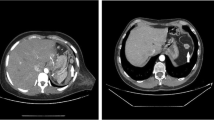Abstract
Postsplenectomy septicemia carries an ominous prognosis. Accompanying disseminated intravascular coagulation and adrenal hemorrhage result in a high mortality, despite aggressive treatment by antibiotics. The efficacy of prevention by in situ partial spleen and splenic auto-transplant were evaluated in Sprague-Dawley rats. All totally splenectomized rats died following intravenous challenge of liv pneumococcus. Both partial spleens and autotransplants gave substantial protection. The rats which succumbed to pneumococcal sepsis demonstrated massive fibrin thrombi in renal glomeruli and frank adrenal hemorrhage, strikingly similar to clinical observations.
Similar content being viewed by others
References
Balfanz JR, Nesbit ME, Jarvis C, Krivit W. Overwhelming sepsis following splenectomy for trauma. J Pediatr 1976; 88: 458–460.
Haque AU, Min KW, From P, Song J. Postsplenectomy pneumococcemia in adults. Arch Pathol Lab Med 1980; 104: 258–260.
King H, Schumaker HB Jr. Splenic studies: 1. Susceptibility to infection after splenectomy performed in infancy. Ann Surg 1952; 136: 239–242.
Amjad H, Congco E, Tranchida L, Bishop CR. Peripheral gangrene and coagulopathy in a splenectomized Hodgkin's disease patient. W Va Med J 1978; 74: 264–268.
Kingston ME, MacKenzie CR. The syndrome of pneumoccemia, disseminated intravascular coagulation and asplenia. Can Med Assoc J 1979; 121: 57–61.
Askergren J, Bjorkholm M. Postsplenectomy septicemia in Hodgkin's disease and other disorders. Acta Chir Scand 1980; 146: 569–575.
Bourgault AM, Scoy REV, Wilkowske CJ, Zincke H, Sterioff S. Severe infection due to Streptococcus pneumoniae in asplenic renal transplant patients. Mayo Clin Pro 1979; 54: 123–126.
Dailey MO, Coleman CN, Kaplan HS. Radiation induced splenic atrophy in patients with Hodgkin's disease and non-Hodgkin's lymphomas. N Eng J Med 1980; 302: 215–217.
Kevy SV, Tefft M, Vawter GH, Rosen FS. Hereditary splenic hypoplasia. Pediatrics 1968; 42: 752–757.
O'Neal BJ, McDonald JC. The risk of sepsis in the asplenic adults. Ann Surg 1981; 194: 775–778.
Seeler RA, Metzges W, Mufson MA. Diplococcus pneumoniae infections in children with sickle cell anemia. Am J Dis Child 1972; 123: 8–10.
Singer DB. Postsplenectomy sepsis. Perspect Pediatr Pathol 1973; 1: 285–311.
Ein SH, Shandling B, Simpson JS, Stephens CA, Bandi SK, Biggar WD, Freedman MH. The morbidity and mortality of splenectomy in childhood. Am Surg 1977; 185: 307–310.
Walker W. Splenectomy in childhood: a review in england and Wales, 1960–4. Br J Surg 1976; 63: 36–41.
Hyslop NE, McCluskey RT. Case records of Massachusetts General Hospital. Case 36-1975. N Eng J Med 1975; 293: 547–553.
Goldthorn J, Schwartz AD. The effect of age and postsplenectomy interval on the susceptibility of the asplenic adult rat to pneumococcal challenge. J Surg Oncol 1979; 11: 53–57.
Shinefield HR, Steinberg CR, Kaye D. Effect of splenectomy on the susceptibility of mice inoculated with diplococcus pneumoniae. J Exp Med 1966; 123: 777–794.
Lum LG, Tubergen DG, Corash L, Blaese RM. Splenectomy in the management of the thrombocytopenia of the Wiskott-Aldrich syndrome. N Eng J Med 1980; 302: 892–896.
Cooney DR, Dearth JC, Swanson SE, Dewanje MK, Telander RL. Relative merits of partial splenectomy, splenic reimplantation and immunization in preventing postsplenectomy infection. Surgery 1979; 86: 561–569.
Cooney DR, Swanson SE, Dearth JC, Dewanlee MK, Telander RL. Hetrotopic splenic autotransplantation in prevention of overwhelming postsplenectomy 21. infection. J Pediatr Surg 1979; 14: 336–342.
Leung LE, Szal GJ, Drachman RH. Increased susceptibility of splenectomized rats to infection with diplococcus pneumoniae. J Inf Dis 1972; 126: 507–513.
Cowan MJ, Ammann AJ, Wara DW, Howie VM, Schultz L, Doyle N, Kaplan M. Pneumococcal polysaccharide immunization in infants and children. Pediatrics 1978; 62: 721–727.
Schwartz AD, Goldthorn JF, Winkelstein JA, Swift AJ. Lack of protective effect of autotransplanted splenic tissue to pneumococcal challenge. Blood 1978; 51: 475–478.
Crosby WH, Benjamin NR. Frozen spleen reimplanted and challenged with bartonella. Am J Pathol 1961; 38: 119–127.
Greco RS, Alvarez FE. Protection against pneumococcal bacteremia by partial splenectomy. Surg Gynecol Obstet 1981; 152: 67–69.
Likhite VV. Protection against fulminant sepsis in splenectomized rats by implantation of autothonous splenic tissue. Exp Hematol 1978; 6: 433–439.
Perla D, Marmonstan-Gottesman J. Studies on Bartonella muris anemia of albino rats III. The protective effect of autoplastic splenic transplants on the Bartonella muris anemia of splenectomized rats. J Exp Med 1930; 52: 131–145.
Delany HM, Porreca, F, Mitsudos Solanki B, Rudavsky A. Splenic capping: an experimental study of a new technique for splenorrhaphy using woven polyglycolic acid mesh. Ann Surg 1982; 196: 187–193.
Grosfeld JL, Ranochak Je. Are hemisplenectomy and/or primary splenic repair feasible? J Pediatr Surg 1976; 11: 419–424.
Pearson HA. Sickle cell anemia and severe infections due to encapsulated bacteria. J Inf Dis 1977; 136: S25-S30.
Straunch GO. Preservation of splenic function in adults and children with injured spleens. Am J Surg 1979; 137: 478–483.
Boles ET Jr, Haase GM, Hamoadi AB. Partial splenectomy in staging laparotomy for Hodgkin's disease: an alternative approach. J. Pediat Surg 1978; 13: 581–586.
Newcomer LN, Cadman EC, Proxnitz LR, Fraber LR, Bertino JR. Splenectomy in Hodgkin's disease: no therapeutic benefit. Am J Clin Oncol 1982; 5: 393–397.
Dearth JC, Gilchrist GS, Telander RL, O'Connel MJ, Weiland LH. Partial splenectomy for staging Hodgkin's disease: risk of false negative result. N Engl J Med 1978; 299: 345–346.
Author information
Authors and Affiliations
Rights and permissions
About this article
Cite this article
Haque, A.U., Hudson, P., Wood, G. et al. Splenic autotransplant and residual partial spleen: Prevention of septicemia. The Japanese Journal of Surgery 14, 407–412 (1984). https://doi.org/10.1007/BF02469550
Received:
Issue Date:
DOI: https://doi.org/10.1007/BF02469550




